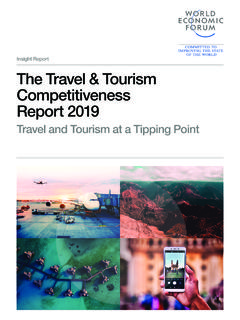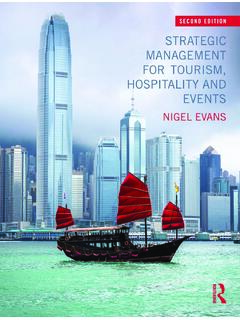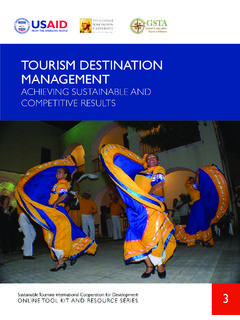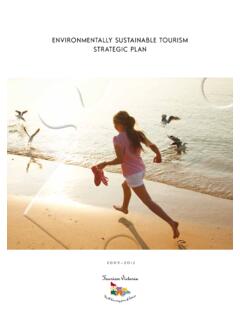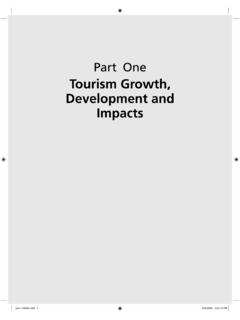Transcription of Tourism Impacts, Planning and Management
1 Tourism Impacts, Planning andManagementPeter MasonAMSTERDAMBOSTONHEIDELBERGLONDONNEW YORKOXFORDPARISSAN DIEGOSAN FRANCISCOSINGAPORESYDNEYTOKYOT ourism Impacts, Planning andManagementButterworth-HeinemannAn imprint of Elsevier Linacre House, Jordan Hill, Oxford OX2 8DP200 Wheeler Road, Burlington, MA 01803 First published 2003 Copyright 2003, Peter Mason. All rights reservedThe right of Peter Mason to be identified as the author of this workhas been asserted in accordance with the Copyright, Designs andPatents Act 1988No part of this publication may be reproduced in any material form (including photocopying or storing in any medium by electronic means and whetheror not transiently or incidentally to some other use of this publication) withoutthe written permission of the copyright holder except in accordance with theprovisions of the Copyright, Designs and Patents Act 1988 or under the terms ofa licence issued by the Copyright Licensing Agency Ltd, 90 Tottenham Court Road,London, England W1T 4LP.
2 Applications for the copyright holder's written permission to reproduce any part of this publication should be addressed to the publisherPermissions may be sought directly from Elsevier s Science and Technology Rights Department in Oxford, UK: phone: (+44) (0) 1865 843830; fax: (+44) (0) 1865 853333; e-mail: You may also complete your request on-line via the Elsevier homepage ( ), by selecting Customer Support and then Obtaining Permissions British Library Cataloguing in Publication DataA catalogue record for this book is available from the British LibraryLibrary of Congress Cataloguing in Publication DataA catalogue record for this book is available from the Library of CongressISBN 0 7506 5970 XTypeset by Newgen Imaging Systems (P) Ltd, Chennai, IndiaPrinted and bound in Great Britain For information on all Butterworth-Heinemann publicationsvisit our website at my Family and Friends in the North and Friends in the SouthContentsPrefaceixAcknowledgementsxi Part OneTourism Growth, Development and Impacts1 Social change and the growth of tourism32 Theoretical perspectives on Tourism development193An introduction to Tourism impacts274 The Economic Impacts of Tourism345 The Socio-cultural impacts of tourism426 Environmental impacts of tourism52 Part Two Tourism Planning and Management : Concepts, Issues and Players7 Tourism Planning and Management .
3 Concepts and issues658 The key players in Tourism Planning and management819 Visitor management9810 Managing the natural resources for tourism10911 Tourism Planning and Management and thehost community11712 Tourism Planning and Management and the Tourism industry12513 Partnerships and collaboration in tourism133vii Part Three Tools and Techniques in Tourism Planning andManagement14 Education as a technique in Tourism Planning and management14315 Self-regulation as a technique in Tourism Planning and management15216 Information technology and Tourism Planning and management159 Part FourThe Future of Tourism Planning and Management17 Tourism Planning and Management and sustainability16518 Conclusions and the future of Tourism Planning and management175 References182 Index192 Contentsviii PrefacePart OneThe first six chapters of the book discuss the growth, development andimpacts of Tourism . It is assumed that all readers will have some under-standing of the concepts of Tourism .
4 However, a brief discussion on theemergence and development of Tourism is provided in Chapter 1. Thereasons behind the development are also provided in this first chapter attempts to establish the global significance of Tourism , but italso points out some data limitations. Chapter 2 provides a discussion ofkey theories that are important within the context of Tourism planningand Management . Chapter 3 indicates that much Tourism Planning andmanagement takes place in relation to Tourism impacts. This chapter alsoconsiders factors that influence Tourism impacts. The three chapters fol-lowing Chapter 3 consider in turn, economic impacts, socio-culturalimpacts and environmental impacts. Case studies are provided in eachchapter to exemplify these different impacts. These studies are alsoemployed to provide stimulus material for students and at the end of eachchapter a number of student activities are TwoChapters 7 13 discuss concepts of, issues concerning and the playersinvolved in Tourism Planning and Management .
5 Chapter 7 focuses on keyconcepts in Tourism Planning and Management . It investigates the generalrelationship between Planning and Management before a discussion oftourism Planning and Management . This chapter also focuses on policyissues and introduces ideas in sustainability in Tourism . Chapter 8 con-siders the major players in Tourism Planning and Management and dis-cusses visitors, host communities, the Tourism industry and chapter also discusses the role of the media and non-governmentorganizations in Tourism Planning and Management . Chapters 9 13 pro-vide more detailed discussion of visitors, host communities and thetourism industry, as well as focusing on the environment as a keyresource in Tourism and the role of partnerships and collaboration inix Tourism Planning and Management . As with the first part of the book, thisone uses a number of case studies. Here they are used to illustrate majorconcepts, themes and issues and once again a number of student activitiesare linked to the case studies in each ThreeThis section is concerned with particular techniques used in Tourism plan-ning and Management .
6 It focuses on education and the role of interpreta-tion (Chapter 14), self-regulation in Tourism Planning and Management ,and in particular codes of conduct, (Chapter 15) and the use of informa-tion technology as a tool in Tourism Planning and Management . As withprevious sections, case studies are an important feature of these chaptersand as before they are included to provide stimulus material for FourThe final part of the book is concerned with sustainability issues andtourism Planning and Management . A number of theoretical perspectivesare discussed and a case study, with accompanying student activities, ispresented to investigate some of these perspectives. A short concludingchapter is also provided and in addition this has ideas on the future oftourism. This final part of the book also uses a case study with relatedquestions for AcknowledgementsIt is a truism that no book is the product of one person alone.
7 I would liketo thank the following for their help, either directly or indirectly, duringthe writing of this academics who informed the development of this book arenumerous, but in particular, I would like to thank the following: at theUniversity of Luton, Andrew Holden; in New Zealand, Sarah Leberman,Joanne Cheyne, Stephen Legg and Belinda Bonzon-Liu; and in Canada,Margaret Johnston and Dave at Massey University, New Zealand and the University ofLuton, UK who tolerated, and may even have enjoyed, trial runs of someof the material contained in the book, deserve a special Butterworth-Heinemann, I would like to express my thanks toSally North, Holly Bennett and Rachael Williams for their advice onthe practicalities of this book s production. I would also like to thankMukesh V. S. at Newgen , but not least, I would like to thank my family, Patsy, Jess and Will,who put up with the long hours I spent at the computer.
8 The author and publisher would like to thank the following for permis-sion to use copyright material:Prosser, R., Tourism Figure 7, in The Encyclopaedia of Applied Ethics(1998)Vol. 4, p. 381, published by Harcourt (Elsevier Science), New York. TheMain Sectors of the Tourism Industry, Figure 4 in Tourism MarketingbyMiddleton V. (1994), published by Butterworth, London. Table 1 andTable 2 in Tourism Collaboration and Partnershipsby Bramwell, B. andLane, B. (2000), published by Channel View Publications, Clevedon, 1, p. 60, A classification of travellers and tourists in Travel, Tourismand Hospitalityby Ritchie, J. and Goeldner, C. (1994), published by JohnWiley and Sons, New York, Some Important Dates in the Growth ofTourism. Figures 21 and 22 in Tourism : Environment and DevelopmentPerspectives by Mason, P. (1990), published by World Wide Fund forNature, Godalming, UK. Figures and , Table and Boxes and in Sustainable Tourism Managementby Swarbrooke, J.
9 (1999),published by CABI, Wallingford, Oxford. All the photographs were takenby the attempt has been made to trace all the copyright holders, but if anyhave been inadvertently overlooked the publishers will be pleased tomake the necessary arrangements. Acknowledgementsxii Part OneTourism Growth,Development andImpactsIntroductionTourism is now a global industry involving hundreds of mil-lions of people in international as well as domestic travel eachyear. The World Tourism Organization estimated (WTO, 2002)that there were 698 million international travellers in 2001 (thisamounts to approximately 10 per cent of the world s popula-tion). Although some of this activity may comprise the sametravellers involved in more than one journey per year and hencethe precise scale of Tourism as an industry is in some doubtLearning objectivesAt the end of this chapter you should: be aware of a variety of definitions of Tourism ; be aware of a number of dimensions and components oftourism, viz.
10 The components of the Tourism industry,motivations for Tourism , Tourism systems, data limitationsin Tourism ; understand major social and economic changes thathave contributed to the growth of change and the growth oftourism (Leiper, 1999), tens of millions of people globally work directly in theindustry and many more are employed indirectly. Hundreds of millionsof people are on the receiving end of Tourism activity as they live in whatare termed destination areas, in supposed host populations. Millions ofdollars are spent each year advertising and promoting holidays andtourism much of recorded history, travel was difficult, uncomfortable,expensive and frequently dangerous (Williams, 1998). Yet journeys wereundertaken and this implies some strong motivating factors. However, itis only in the last 150 years, as travel has become more affordable and lessdifficult, that some of those who travelled were prepared to openly admitthat pleasure was one of the motivations for their recently as the 1960s, Tourism was an activity in which relatively fewparticipated regularly, and was primarily confined to Europe, NorthAmerica and a small number of locations in other parts of the travel, prior to the 1960s, was still largely the preserve of awealthy minority who had the time as well as money to afford long dis-tance sea or air travel.

